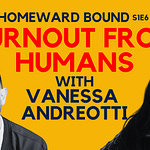My guest in this episode is Jay Cousins, an inventor, recovering entrepreneur and carrier of questions, an old friend from my Sheffield days, who has been based for the past ten years or so in Dahab, Egypt. This conversation came about because Jay wrote to me with a set of thoughts that build on the unfinished list of “Four Tasks for a Time of Endings” from the closing pages of At Work in the Ruins.
The original set of tasks goes like this:
Salvage the good things we have a chance of taking with us.
Mourn the good things we have to leave behind – and do this, not least, by telling their stories, because these stories may turn out to be seeds in futures we can’t imagine yet.
Notice the things that were never as good as we told each other they were about the ways we’ve been living around here lately, and the chance we’re given to leave these behind.
Look for the dropped threads from earlier in the story and the chance to weave these back in – the things that have been marked as old-fashioned, inefficient, obsolete, but that might turn out to make all the difference on the journey ahead.
In the course of this episode, Jay brings up five questions that follow on from these tasks:
What should we seek to use before we lose it?
What can we produce now, knowing what is coming?
What can we evolve from things we’ll lose?
What are the seeds of the things we mourn – and how do we harvest these?
What do we need to learn and teach future generations?
You can listen to Jay’s regular mini-podcasts at Make Kindness Easier! The Stone Paper product is being developed by the folks at Solar Punk Now. He’s @jaycousins on Twitter and here’s his LinkedIn.
Show Notes
We mention Vanessa Machado de Oliveira’s Hospicing Modernity and how she couples the work of hospicing to the work of “assisting with the birth of new, as-yet-unknown, and potentially – but not necessarily – wiser”.
Richard Smith’s review of At Work in the Ruins in the British Medical Journal applies the original “four tasks” to the fields of medicine and public health.
Jay introduces the work of Dave Hakkens and One Army – and especially the Precious Plastic project.
Talking about what we should “use before we lose” takes me to a conversation with the Solarpunk theorist Jay Springett where he suggested using today’s earth-moving machines to do landscaping for permaculture that will continue to be useful long after the fossil fuel era is over.
Jay’s Stone Paper.
Martín Prechtel, The Unlikely Peace at Cuchamquic on the centring of seeds within Mayan culture.
The Decelerator supports civil society organisations to create good endings (discussed in the #DECELERATE episode of The Great Humbling).
End of the World Garden in Cornwall, created by the artist Paul Chaney.
I wrote about Cryptic Northern Refugia in this essay for Alan Garner.
Thomas Keyes’s recipe for October Black Isle Pheasant Stew appeared in Dark Mountain: Issue 2.
Carcinisation is an example of convergent evolution, by which “crabs” evolve from different directions.
Caroline Ross’s Found and Ground as an example of recovering and relearning skills. (I spoke to Caroline in Homeward Bound S1E1.)
Here’s an old post of Jay’s about his first company, Orikaso, and the fold-flat dinnerware products he invented.
Cory Doctorow’s concept of “enshittification”.
Jay’s TEDx talk, where he started sharing his thinking about biomemetic business models.
J.K. Gibson-Graham, The End of Capitalism (As We Knew It).











